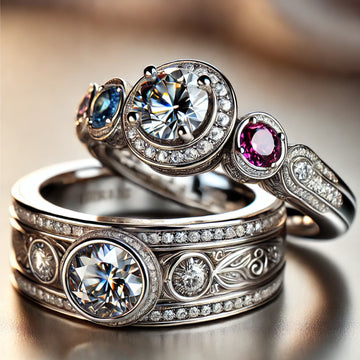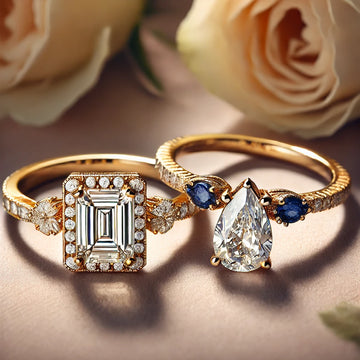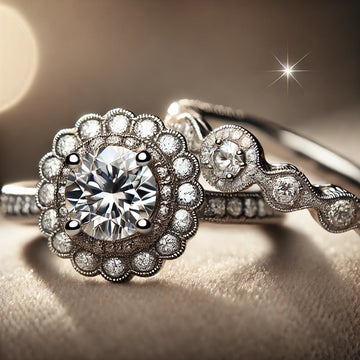Engagement Rings for Every Personality: Find Your Perfect Match
by Keyur Koshiya on Nov 07, 2024

1. Conflict-Free Diamonds
Conflict-free diamonds, also known as "ethical diamonds," are mined and traded in compliance with the Kimberley Process Certification Scheme. This ensures the diamonds are not associated with financing armed conflict or human rights abuses. Always ask your jeweler if the diamond has been certified conflict-free.
2. Lab-Grown Diamonds
Lab-grown diamonds are chemically identical to mined diamonds but are created in controlled lab environments, eliminating the need for mining. They’re often a more affordable and eco-friendly option, as they use fewer natural resources and create less environmental impact.
3. Recycled Metals and Vintage Stones
Recycled metals are repurposed from existing jewelry, electronics, or industrial sources, reducing the need for new mining. Similarly, vintage or antique diamonds reduce demand for new mining and have a unique history and charm. Choosing recycled or vintage materials is a great way to lessen environmental impact.
4. Fairtrade and Fairmined Gold
Fairtrade and Fairmined certifications ensure that the gold used in jewelry is sourced from mines that provide fair wages and safe working conditions. This ethical choice benefits local communities and helps improve environmental practices in mining regions.
5. Eco-Friendly Jewelers
Many jewelers are committed to sustainability, using responsibly sourced gemstones, recycled metals, and sustainable production methods. Some may also donate a portion of proceeds to environmental and social causes. Researching jewelers with a commitment to ethical practices can help ensure your ring purchase aligns with your values.
https://ivevar.com/products/unique-lab-grown-diamond-white-gold-halo-ring-by-ivevar
Vintage vs. Contemporary Engagement Rings
Choosing between a vintage or contemporary engagement ring style can depend on personal preference, lifestyle, and fashion taste. Here’s a closer look at what makes each option unique:
Vintage Engagement Rings
Vintage rings are typically over 50 years old, while antique rings are over 100 years old. These rings often have unique characteristics, intricate detailing, and designs that reflect the artistry of a specific era, making them a charming and romantic choice.
- Art Deco (1920s-1930s) : Rings from this era feature bold geometric shapes, contrasting gemstones, and intricate metalwork, with platinum and white gold being popular metals.
- Victorian (1837-1901) : Victorian rings are often crafted in yellow gold and feature ornate designs, symbolic motifs (like hearts), and colored gemstones, such as sapphires or opals.
- Edwardian (1901-1915) : Edwardian rings are known for their lace-like filigree and delicate designs, often set in platinum with diamonds or pearls for a soft, romantic look.
Vintage rings carry the beauty of history and often use materials that were mined and crafted decades ago, which appeals to those seeking sustainability and timeless elegance.
Contemporary Engagement Rings
Contemporary rings reflect modern trends and advances in jewelry craftsmanship. They can be highly customizable and are often designed with minimalist and sleek aesthetics, or bold and innovative styles.
- Minimalist Designs : Contemporary rings often feature simple bands and settings, focusing on the diamond’s quality and brilliance.
- Modern Halos and Mixed Metals: Mixed metal bands and unique halo designs add a contemporary twist to traditional styles.
- Innovative Cuts and Settings : Unique cuts, such as hexagonal or kite shapes, and settings like East-West or bezel, are popular choices that appeal to those with modern tastes.
Contemporary rings are great for those who enjoy staying on top of trends, appreciate customization, or prefer a cleaner, sleeker look.
Diamond Certification and Grading: Why It Matters When shopping for an engagement ring, it’s important to understand the significance of diamond certifications. A certified diamond comes with a grading report from a reputable gemological lab, providing essential details about the stone's quality and authenticity.
1. Key Certification Bodies
- Gemological Institute of America (GIA): The GIA is widely recognized as the gold standard in diamond certification. It provides thorough and accurate assessments, especially in terms of clarity and color grading.
- American Gem Society (AGS) : The AGS is known for its strict cut grading system, making it an ideal choice if cut quality is a top priority.
- International Gemological Institute (IGI) : IGI certifications are commonly used for lab-grown diamonds. They are generally reliable and provide detailed reports similar to those of GIA and AGS.
2. Understanding Diamond Grading Reports
Diamond grading reports provide specific details on the diamond's cut, color, clarity, and carat weight. Understanding these details helps ensure you’re getting the quality you’re paying for. It also offers peace of mind and protects you from overpaying for a stone that doesn’t meet your expectations.
3. The Importance of Certification
Having a certified diamond increases the stone's resale value, helps with insurance coverage, and gives you confidence in the quality and authenticity of the diamond. Always request a certification for your engagement ring’s center stone, especially if it’s a significant investment.
Matching the Ring to Your Partner’s Lifestyle
It’s essential to consider your partner's lifestyle when choosing an engagement ring. Since they’ll likely wear the ring every day, it should be practical for their daily activities while matching their personal style.
1. Active Lifestyles
For partners with an active lifestyle, durability is key. Rings with secure settings, like bezel or flush settings, protect the diamond better than prong settings. Metals like platinum and titanium are durable and scratch-resistant, making them suitable for active individuals.
2. Professionals in Hands-On Jobs
If your partner works in a hands-on profession—such as healthcare, construction, or art—look for a ring that won’t interfere with their work. Simple solitaire rings, low-profile settings, or designs without sharp edges are generally easier to wear without worry.
3. Fashion-Forward Styles for Trendsetters
For those who enjoy fashion and changing styles, consider a unique or customizable ring. Trendsetters often appreciate mixed metals, alternative stones, or stackable rings that can be paired with other jewelry. Modern, non-traditional designs may be the best fit.
4. Vintage Lovers
If your partner loves antique styles and nostalgic aesthetics, a vintage or vintage-inspired ring could be ideal. Rings from the Art Deco, Victorian, or Edwardian eras offer unique charm and artistic detail that appeals to vintage enthusiasts.
Post-Proposal Care and Maintenance Tips
An engagement ring is a cherished piece of jewelry that will likely be worn every day, so caring for it properly is essential. Regular maintenance will keep it looking as brilliant as the day it was given.
1. Regular Cleaning at Home
Cleaning your engagement ring at home is simple and keeps it looking brilliant. Use a soft toothbrush and a solution of warm water and mild dish soap. Gently scrub the ring, rinse it under warm water, and pat it dry with a soft cloth. Avoid using harsh chemicals or ultrasonic cleaners at home, as they can damage certain stones or settings.
2. Annual Professional Cleaning and Inspection
Once a year, take your ring to a professional jeweler for cleaning and inspection. They can check for loose stones, worn prongs, and scratches, ensuring that your ring stays in excellent condition. Jewelers often use specialized equipment to clean your ring, restoring its original sparkle.
3. Avoiding Chemicals and Harsh Conditions
Avoid exposing your ring to harsh chemicals, such as bleach or household cleaning agents, which can damage both metal and stones. Remove the ring before applying lotions, perfumes, or hairspray, as these can create a buildup on the ring and dull its shine.
4. Protecting the Ring with Insurance
Insuring your engagement ring protects against theft, loss, or damage. Many homeowners’ or renters’ insurance policies offer add-on options for jewelry. Make sure to get an appraisal or certification from your jeweler, as this documentation is often required for insurance coverage.
5. Consider a Safe Storage Option
When not wearing your engagement ring, store it in a soft pouch or a lined jewelry box to avoid scratches and protect it from accidental damage. If you’re traveling, consider leaving the ring in a secure place to avoid misplacement.
Customizing Your Engagement Ring for Personal Significance
A custom engagement ring allows you to create a truly unique and meaningful piece that symbolizes your love and relationship. Customization options include choosing a specific gemstone, incorporating birthstones, or designing a ring that tells a story.
1. Incorporating Birthstones or Meaningful Gems
Adding a birthstone to the engagement ring is a lovely way to make it more personal. You can also add gemstones that hold special significance in your relationship, like the stone from the month you met or a gem that symbolizes shared values.
2. Engraving a Special Message
Many couples choose to engrave the inside of the ring band with a meaningful phrase, date, or initials. Engraving is a subtle yet romantic way to personalize the ring and make it truly unique to your relationship.
3. Designing a Ring from Scratch
If you have a vision for your ideal ring, work with a jeweler to design it from scratch. Custom design allows you to choose every element, from the stone and metal to the setting and style. Custom rings can take time and may be more expensive, but they’re a great option for a one-of-a

 Engagement Ring
Engagement Ring  Anniversary Rings
Anniversary Rings Solitaire Rings
Solitaire Rings Halo Rings
Halo Rings Men's Ring
Men's Ring Toi Moi Ring
Toi Moi Ring Three Stone Rings
Three Stone Rings Nature Inspired Rings
Nature Inspired Rings Rose Cut Diamond Rings
Rose Cut Diamond Rings Fancy Color Rings
Fancy Color Rings Antique Cut Diamond Rings
Antique Cut Diamond Rings Wedding rings
Wedding rings All Lab Grown Diamond Ring
All Lab Grown Diamond Ring Engagement Ring
Engagement Ring  Three Stone Rings
Three Stone Rings Daily Wear
Daily Wear Fancy Color Rings
Fancy Color Rings Antique Cut Diamond Rings
Antique Cut Diamond Rings Earrings
Earrings Bracelet
Bracelet Pendent
Pendent Necklace
Necklace Men's Ring
Men's Ring Bridal Sets
Bridal Sets Rings
Rings Earrings
Earrings Tennis chain
Tennis chain Custom Pendent
Custom Pendent Custom Ring
Custom Ring Custom Teeth Grillz
Custom Teeth Grillz Round
Round Oval
Oval Cushion
Cushion Marquise
Marquise Pear
Pear Emerald
Emerald Heart
Heart Princess
Princess Rose Cut
Rose Cut Radiant
Radiant Antique Cut
Antique Cut



